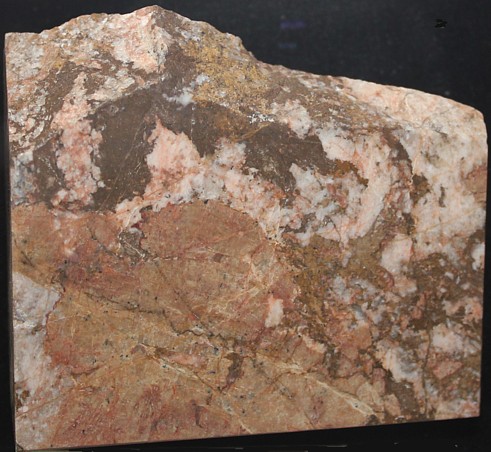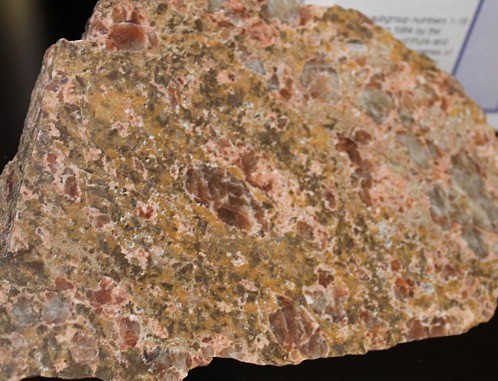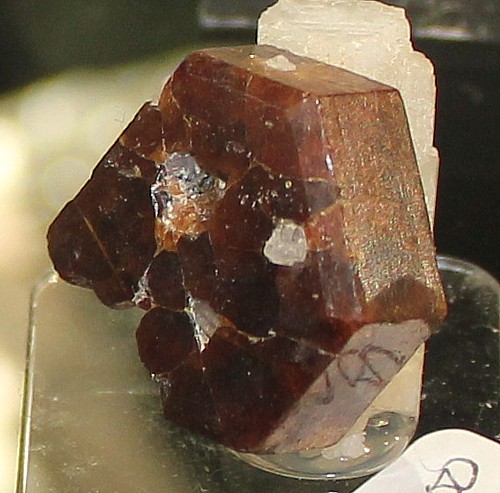|
.
Bastnaesite Mineral Facts:
Chemical Formula: CeCO3(OH,F)
Cerium Fluoro-Carbonate.
Cerium is the dominant metal ion, but various rare earth metals
substitute for cerium in the formula. Mineralogically,
bastnaesite is divided into three
minerals, cerium rich, lanthanum rich and yttrium rich forms.
Colors:
Honey-yellow to reddish brown.
Hardness:
4 to 5
Density: 4.95
to 5
Cleavage:
Imperfect to
indistinct parallel to (1010).
Crystallography: Hexagonal
Usually as
inclusions within other rocks such as carbonatite intrusives. However,
rare and
fine crystals do occur.
Luster:.
Vitreous
luster. It is transparent to translucent.
Optics:
(Refractive Index):
w
= 1.72, e = 1.82
|

Bastnaesite (Brown) ore from Mountain
Pass, California |
|
Composition,
Structure and Associated Minerals:
Bastnaesite
is
found in carbonatite intrusive
rocks, contact metamorphic zones and pegmatites. It has been found as a
residual mineral in karst (limestone derived)
bauxite deposits. The formula is variable and cerium is commonly
substituted by the light rare earths, lanthanum, yttrium, and thorium. It
ranges in color from wax-yellow to a deep reddish-brown. Bastnaesite is
commonly associated with other rare-earth-bearing minerals such as allanite,
cerite, and tysonite. In the US, Bastnaesite occurs in pegmatites near Pikes
Peak, Colo. and with
fluorite in Lincoln County, New Mexico; it is also commercially mined at
Mountain Pass, Calif.
where it is associated with
barite,
calcite,
and
barite.
The finest specimens of bastnaesite are from
the Zagi Mountains in Pakistan. Until recently, bastnaesite was basically an
industrial mineral found only as crusts, or inclusions within carbonatite
and other rocks. This new find from the tribal areas of Pakistan, has
produced the first fine quality crystals of this mineral.
Identification and Diagnostics
Bastnaesite
is normally slightly radioactive due to associated thorium content. It
is soluble after heating in hydrochloric acid.
Occurrence,
Localities and Origins:
It is an important ore of
the rare earths, especially the lighter end
members, including europium.
Bastnaesite
is the most important ore mineral at the Mountain Pass mine in San
Bernardino, California near the Nevada border. It ceased active mining in
2002 but is in the process of returning to production because of high rare
earth prices. Mineralization occurs in Precambrian metamorphic and igneous
rocks. The carbonatite complex here constitutes one of the worlds largest
lanthanide rare earth deposits. It is composed of eight 100 to 2000
meter-long plugs of carbonatite intrusive rocks and about 200 smaller dikes.
Bastnaesite is also an important ore mineral at a number of other rare earth
mines in China, including several deposits in Sichuan Province, and the
massive deposit at Bayan Obo, Inner Mongolia.
Until the recent deposit in Pakistan was discovered, it
was not normally used as a mineral specimen, but the fine crystals of this
new discovery
are highly valued by
mineral collectors. The single crystal at left is from the Pakistani
deposits.
Return to the
Mineral Collectors Information Page |

Bastnaesite ore from Mountain Pass,
California |
|



